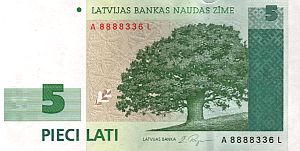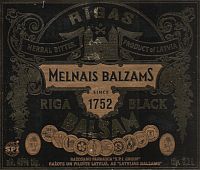Prologue
Latvia was - after Lithuania - our second stop on our tour through the Baltic States. We were quite curious about the difference between the countries. Unfortunately we only had time for a three days stay in the capital. Therefore, information about Latvia on this website is limited to the capital. We had the chance for a very short glimpse of the city of Daugavpils in the east of Latvia - as far as we could tell, the difference to the capital was as big as it could be.
Visa
Most Europeans and many other nationalities do not require a visa for Latvia. Some European nationalities don't even need a passport but only their ID card to enter the country.
Money
The national currency is called Lats (Plural: 2-5 Lati, more then 5: Latu), the international abbrevation is Ls. One Lats consists of 100 Santīmu. The currency is tied to the Euro but hasn't obliged to the Exchange Rate Mechanism II, which means that it might take some time until Latvia joins the Euro zone. The average exchange rate in 2004 was 1 Euro = 0,67 Ls. This means that 1 Lats is worth € 1.5.
The smallest bill is already worth 5 Lati. Other bills come in 10, 20, 50, 100 and 500 (= € 750!!!) Latu nominations, with the latter being naturally a very rare appearance. Coins come in 1, 2, 5, 10, 20 and 50 Santimi and 1 and 2 Lats. The 1, 2 and 5 Santimi coins look very much the same as Euro cent coins, so you'll have to look twice when coming from a Euro country.
It's as easy to withdraw money in Estonia as it is in any other central or western European country. ATM's are everywhere, accepting all common credit and cash cards, such as Cirrus- and Maestro cards etc. Many banks also exchange foreign currencies. Needless to say that the Euro is the best foreign currency to get along with in Estonia. Most banks charge € 4 or so as a fee for transactions using foreign cash cards.

| ||
| 5 Latvians Lats - worth 7.50 Euro! |
Costs
As mentioned above, we only really stayed in Riga - and as everywhere else, the capital is more expensive then the rest of the country, so the following information mainly refers to the capital and is not necessarily valid for the rest of the country.
Travelling in Latvia is comparatively cheap. Even in the center of the capital it's no problem to find a place to stay for less then € 10 (or 7 Lats). And there are places to eat for a euro or so. But visitors have the choice - depending on what you want, you can leave a lot of money in the country, but it's mostly worth it. Rather modest travellers can enjoy a day in the capital for as less as 15 Lats a day, but again, it's worth to pay more for good quality.
Especially when it's about food, Latvia, at least in the capital, offers a fascinating variety. Travellers can choose between pigging out in a Pelmeni bar for 1 Lats or dining out in one of countless more or less modern restaurants such as the Ćili Pica (with several branches in Riga) where it's easy to pay 6 Lats or more for a good meal. We were dining out quite often, and the food was always of high quality and worth the money. Since Latvia isn't very large, transportation cost isn't an issue as well.
Getting there
There aren't many direct flights from outside Europe to Latvia, but many flights - including cheap airlines - from major European cities. In autumn 2004, one of the cheaper airlines, www.easyjet.com, offered flights from Berlin for example to Riga for 29 € (one way). Adding the usual taxes, it's possible to fly to Riga from some major cities in Middle Europe. The best bet is to book a few weeks in advance and via internet. There are of course many other carriers offering regular flights to and from Riga.
Another option is to go by boat. Not far from the old town of →Riga lies the Rīgas Pasažieru Osta (Passenger terminal). From there, regular ferries connect the country with Stockholm for example. The ride takes around 8 hours and is limited to the summer months. Occasionally there are ferries from Lübeck (Germany) to Riga and from Rostock (Germany) to Liepaja, but it's better to do some research beforehand since there's no reliable schedule.
Unfortunately, trains are becoming more and more unimportant in Latvia. But there are a few international train connections left, although busses are often faster, more frequent and less expensive. Train service to →Tallinn already has been suspended completely, and it looks like the same can be said about services to →Vilnius. But there are two trains a day from Riga to Moscow (16½ hrs) and one per day to St. Petersburg (12½ hrs). There is also one daily train to →Minsk (Belarus) (around 12 hrs) and to Gomel (also in the →Belarus). Trains to Minsk leave Riga in the evening and cross the Belarusian border a few minutes before midnight - which means that they can't be used if the visa starts only on the next day.
The most important means of transportation in the area is the bus. The dominating bus company is called Eurolines and has many daily departures to →Tallinn. The trip takes around 5 hrs and costs 8.5 Lats (13 €) from Riga to Tallinn or 230 EEK (15 €) from Tallinn to Riga respectively. The same company dominates the route between →Vilnius and Riga. This takes some 4 hrs and costs 40 Lt (11 €) per person. Eurolines has many other routes - ranging from major cities in Western Europe to connections from Russia to Latvia. Another bus company called Nordeka runs buses from Riga to →Minsk. There are two busses a day - one runs during the day and costs 9 Lss, another one leaves at 21:20 and makes a good alternative to another night in a hotel - the coach is very convenient for having a nap. The night bus costs 10 Ls. Both buses start in →Riga. The night bus stops for a while in Daugavpils some time after midnight and arrives at around 7 am in Minsk next to the main train station.
Border crossings
There are numerous border crossings to →Estonia in the north and to →Lithuania in the south as well as some crossings to the →Belarus and to Russia in the east. Note that everyone has to obtain a visa beforehand - there is no way of crossing the border without.
Border procedures
The usual EU customs guidelines apply to Latvia. Crossing the border is no problem at all and takes a few minutes only. There are no special rules or requirements (as opposed to the Belarus for example).
Food and drinks

| ||
| Balsam - Latvian herb liquor |
What is Latvian food? Is there a Latvian cuisine? We couldn't really get an answer on this. No exotic ingredients limited to Latvia only but a lot of potatoes, cabbage, pork, cabbage rolls etc. One dish seems to be rather unique and can be seen quite often - Zirni. Zirni mainly consists of steamed black beans. Another typical snack is Sieriņš - cream cheese, coated with something that tastes like fruit. The latter is really a snack only, I haven't seen it in restaurants.
Since there is a large Russian minority, it doesn't come as a surprise that there is a lot of Russian food. Some restaurants for example specialize on the typical Russian Pelmeni (dumplings, mainly filled with pork). Especially the capital offers a lot of international cuisine - with numerous Italian, Chinese, Irish and other restaurants, bars etc. Note that a Latvian Bar almost always offers a good selection of food, too.
Needless to say that there is plenty of beer and vodka and other alcoholic beverages. Many beer brands have a high malt level, are rather sweet and with 7-8% relatively strong - not everyone likes this taste. One local, popular brand is the Zelta (=gold). Latvia also produces some vodka brands. Still, if not coming from Russia, I'd like to recommend a Russian vodka brand which can be found in almost every bar in Riga - the Standart. 5 cl (standard size) cost around 1 Lats and in my humble opinion - this is one of the three top vodka brands in the world. If not the #1. Even someone who doesn't like vodka until now should give it a try. But don't dare mixing it with orange juice!
Quite (in)famous is a Latvian herb liquor called Balsam, made in Riga. This black and thick firewater has a ... distinctive taste and 45% alcohol. It's sold almost everywhere and not very expensive.
©2024 Europe-East.com

 Albania
Albania Latvia
Latvia